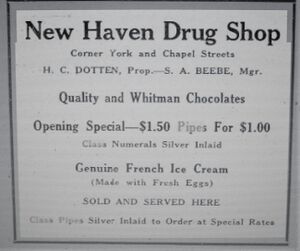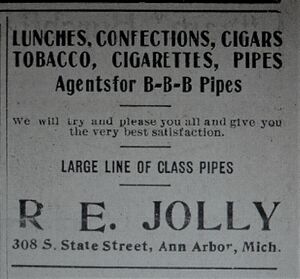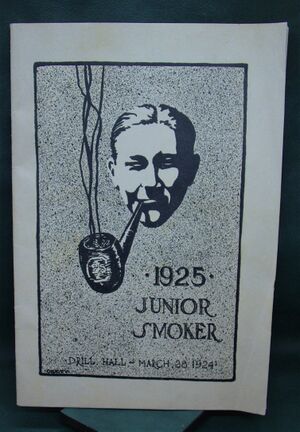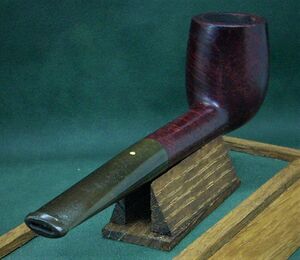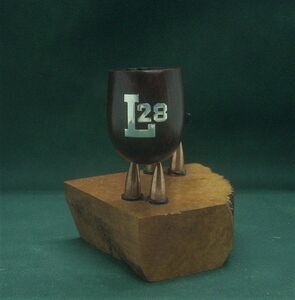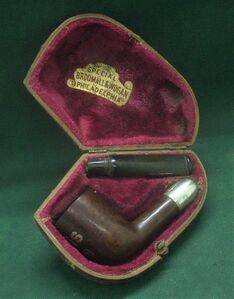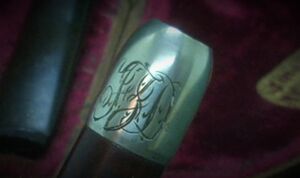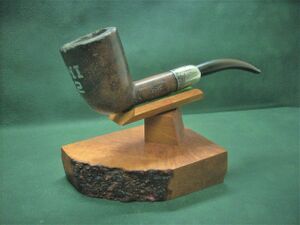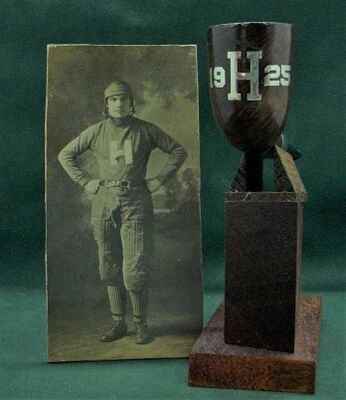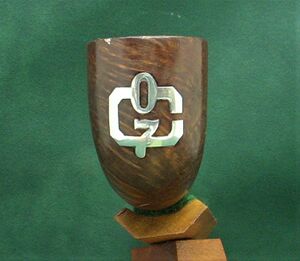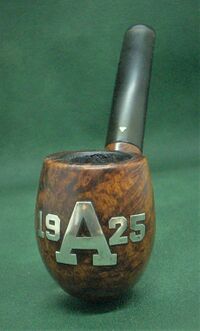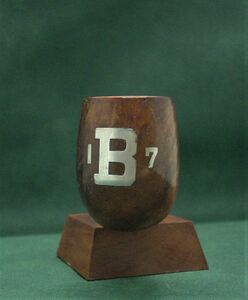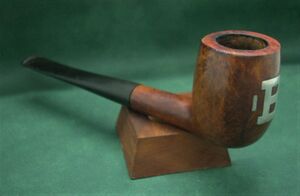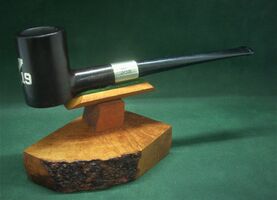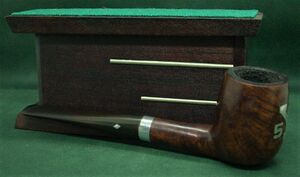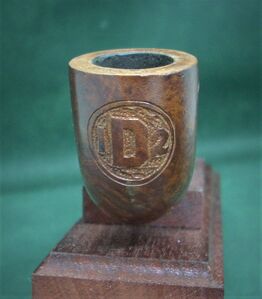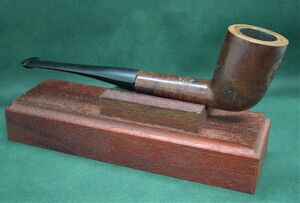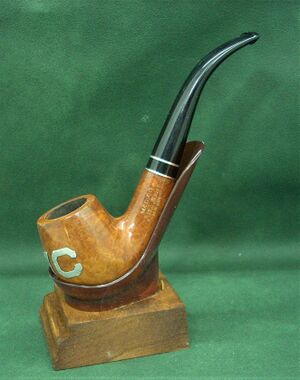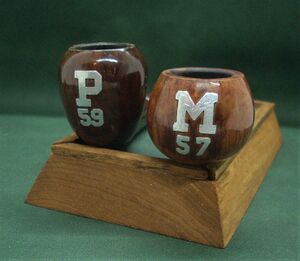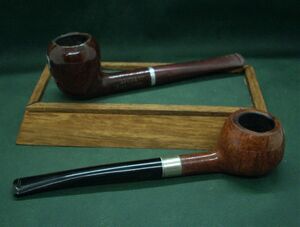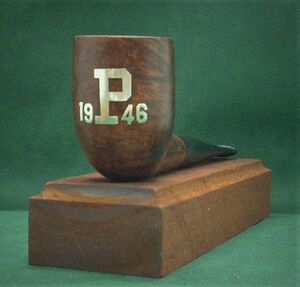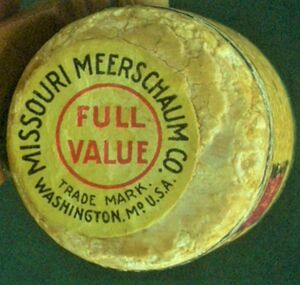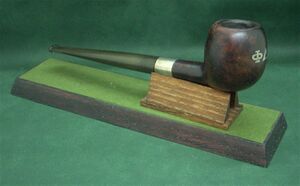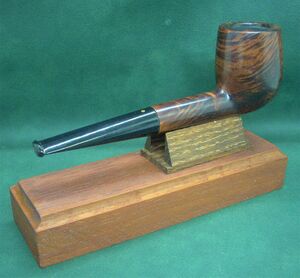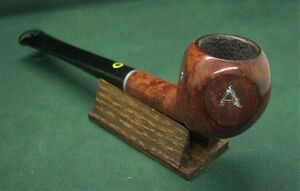College Class Pipes
A brief treatise by avid collector, Brian Robertson
“Arthur held a heavy buldog Yale class pipe in his hand, the pipe had a large 'Y' on the front, flanked on each side by numerals,,,,,1907”
-- from Eugene O'Neill's play, Ah, Wilderness!


Introduction and Origins of The Class Pipe Tradition

Around 1900 and slightly earlier, pipe smoking on college campuses, by faculty and students, seems to have been the tobacco implement of choice. From the 1890's until at least the early 1940's , the pipe was the "big man on campus". My research indicates that several Eastern colleges in the late 1800's had a single "class pipe" that was smoked during a school ceremony, marking the end of a school year. Emulating early western movie scenes, the pipe was passed among faculty and chosen ranking students, not unlike the native American "peace pipe" shown in those same films. Some colleges even had a pipe annually used in a ritual, not a "class pipe", but literally referred to as "the peace pipe". This "peace pipe” was smoked by the warring "tribes" of the senior and junior classes, symbolically ending their conflict as the seniors graduated.
During a period when pipe smoking registered among the principle pastimes cultivated by students, a yet to be credited marketing genius came up with the idea to place a silver letter on the outward facing bowl of a pipe . Young men couldn't wait to have someone remark "oh, you must be a Yale man", or Princeton, or Harvard, etc.. Then around 1900, Mr. Lew L. Stoddard came up with an idea that would change the fad into a tradition. He put a student’s class year on the pipe, along with the school initial. Student class pride and rivalries were fierce, so this was an excellent way of displaying "class pride". In a 1908 ad, Mr. Stoddard claims to be "the originator of numerals on the class pipe". In a recently found earlier ad Mr. Stoddard claims to be the originator of the "class pipe", and he may well be. Yale university may have been the first college to adopt the "student class pipe". In a 1900 newspaper article it is reported that Yale students would adopt a class pipe instead of their usual class cane, which I have to assume was the current tradition of the period. It appears this was not done as a substitute for the original single class pipe, used in the year end ritual, but the beginning of a new tradition for students.
Although not a class pipe, the pipe to the right and below is a thick branch of the family tree. The class day pipe ceremony began at Yale in 1859. The purpose of the rite was to have senior students gather, smoke a single bowl of tobacco, and afterwards smash the pipe on the ground. This was intended to signify the students' end of days at Yale. This tradition was performed for over 100 years and revived in 2018. The pipe pictured is an 1898 Princeton Class Day Ceremony pipe. Unlike Yale, that crushed Class Day pipes underfoot. Princeton grads, hurled their clay pipes at a partially buried cannon, referred to as "The Great Totem", with intent of striking and breaking the pipes against it.Signaling the end of their days, at Princeton University. (see the Princeton ceremony photo) The rarity of this pipe cannot be overstated. The combination of fragility, age, and that its purpose was to be destroyed upon a single use, should have created a "perfect storm" of destruction. Regarding the pipe itself, the Princeton insignia , appears to have been hand painted, and the numerals are "raised". Although the pipe has not been smoked, the exterior has not been cleaned. The display stand is a deserved recent addition.
- Rare 1898 Princeton Class Day Ceremonial Clay Pipe, courtesy Brian Robertson
As the popularity of the class pipe grew, more local pipe shops and tobacconists added class pipe offerings to students. In many cases campuses elected students to "class pipe committees" to seek out new designs for each year. The samples would then be voted on, and students would place orders on the winning design. In a 1912 article this process was mentioned as taking place at Purdue University in Indiana. Ads for class pipes from around the same period have been seen as far west as Idaho University. I recall reading a mention of a West Point class pipe (circa 1907), that had raised letters and numerals upon a silver shield. The cadet would need a strong jaw, and perhaps wear a glove to protect his hand from being burned after a couple of bowls had been smoked in such a design.
Many pipe shops offered "class pipes" across the country. They would charge a fee for the school letter, and an additional fee for each numeral. The famous Yale University Owl Shop was one of these shops, and the venerable J. Middleton shop of Philadelphia was a nationwide source for class pipes.
- Class pipe ads, courtesy Brian Robertson
- 1907 Yale Class Pipe, in Meerschaum, which is very rare. This is the only meerschaum Class Pipe seen by the author. Courtesy Brian Robertson collection
Clues to Matching a particular pipe to its College or University

There are several clues that can be used to provide a degree of provenance in matching a class pipe with its corresponding college or university. An excellent method of determining a class pipe’s identity is researching college and university student newspapers. Many of the eastern college student newspapers have archives that can be viewed. For instance, if you have a pipe emblazoned with a "C" and a year, and you guess that it is a "Cornell" pipe, upon visiting newspaper archive you can search "class pipe (plus the year") or "class pipe committee (plus the year) ". The result in some cases will be an article actually describing the design of the chosen silver letters, and numerals. The article may even declare the brand of pipe, and its corresponding shape (straight or bent). This method is not always fruitful and oftentimes requires slogging through a long list of articles. It is heaven for the research geek. When I purchase a pipe at an estate sale, I simply ask to whom the pipe belongs. Usually I am told that it was their father's or grandfather's. I then ask, "did he go to college and which one?" I learned the hard way, you ask these questions after you have paid, and the pipe is in your pocket. Another clue is the source of the pipe. The Owl Shop has supplied, almost exclusively, the "Yale" pipes. The 1917 Brown University pipe was branded by a tobacconist that was practically on the campus. With others, a lucky google search of the tobacconist name on the pipes will sometimes turn up the store's location.
I bought a class pipe in Ann Arbor, Michigan at a garage sale that had numerous University of Michigan items. I asked where they all came from and was told by the seller that her husband's grandfather graduated from Michigan and the pipe had been his. Surprisingly, even eBay sellers have been helpful. After purchase, and tracking showing the pipe had shipped, I simply ask the seller, if they knew, or could find out any provenance regarding the purchased pipe. Several were selling for friends and provided school provenance.. A pipe that is pre 1910 can safely be assumed to have come from a large eastern college as it took some time for the "fad" to move west.
The Class Pipe Committee Process
The "class pipe committee" that was either appointed or elected were in charge of selecting or creating a new design annually. The committee would seek out several pipe shops and present their design. The pipe shops would look over the designs, suggest a current popular brand pipe and offer a discounted price on the pipe itself and a separate price for the design and numeral application. This "bargain arrangement" was contingent on a predetermined number of students ordering the class pipe. In several articles the number of required student orders seems to have been100. This appears to have been the general process from the early 1900's through the twenties. Around 1930, with the financial devastation of the Great Depression, class pipe references are scarce during this decade. I even ran across a class pipe selection being a Sasieni "sub-brand". Formerly, only top of the line pipes were selected. The tradition returned in the 1940's, but without previous earlier years interest.
The Waning of the Once Thriving Tradition
In my opinion the interest in the class pipe tradition slowly disappeared as a result of diminished pipe smoking on campuses, with the increased popularity of cigarette smoking following World War II. Simply put, in the 50's and 60's , the majority of young college men felt they had a "cooler" image while smoking a cigarette. By the early to mid 1960's, the class pipe tradition had essentially, vanished.
Author's Note:
I apologize for not saving my many google search sources for this information. At the time, I did not consider the countless hours I spent poking around on google would lead to documenting my hobby of collecting Class Pipes. I feel, while perhaps not worthy of a dedicated chapter in Pipe History, Class Pipes are at least worthy of a footnote. Brian Robertson
The Collection
- 1927 Loyola Class Pipe, by Dunhill, with a 1925 PAT., courtesy Brian Robertson collection
- 1926 Patent Dunhill AO Innertube Patent 1928 Lehigh/Loyola Class Pipe (Restored by Steve Charbonneau). Courtesy Brian Robertson collection
- This class pipe was owned by Douglas S. Widnall. Brown University class of 1937. Mr. Widnall was captain of the track team and a member of the Theta Delta Chi fraternity. Mr. Widnall passed away in 1991. The pipe was obtained from his granddaughter.
- 1906 WDC Cornell Class pipe w/case, courtesy Brian Robertson collection
- 1909 BBB Glokar, Emory University Class pipe, courtesy Brian Robertson collection
- 1909 John Middleton Harvard School of Surgery Class Pipe with Original Case. The Sterling Ferrule has engraved the three initials of the student. Courtesy Brian Robertson collection
- 1947 John Middleton Cornell Class Pipe with Ashtray and silver Cornell Football. Courtesy Brian Robertson collection
- 1925 Harvard University WDC Stratford, courtesy Brian Robertson collection
- 1906 WDC Columbia Class pipe, courtesy Brian Robertson collection
- A much loved VMI 1921 WDC ABC, courtesy Brian Robertson collection
- 1913 University of Michigan Class Pipe, a near mint 1912 BBB Glokar, courtesy Brian Robertson collection
- 1934 Brown University Middleton 'Selber' Class pipe, courtesy Brian Robertson collection
- 1949 Briarcraft William & Mary Class pipe, courtesy Brian Robertson collection
- WDC 1925 Class Pipes, courtesy Brian Robertson collection
WDC Stratford, 1925 Harvard Class Pipe
WDC Milano, 1925 Amherst College Class Pipe
- 1930 Ursinus College Class Pipe, a WDC Hesson-Milano with a 1925 Patent, courtesy Brian Robertson collection
- Middleton 1913 University of Pennsylvania Class Pipe, courtesy Brian Robertson collection
- An unsmoked 1951 Yorktown Class Pipe by the Owl Shop, courtesy Brian Robertson collection
- Colossus Pipe Factory 1905 and 1907 Cornell Class Pipes, courtesy Brian Robertson collection
- WDC-Milano 1925 Amherst College Class Pipe, courtesy Brian Robertson collection
- BBB Own Make, Glokar 1918 Cornel Class Pipe, courtesy Brian Robertson collection

- 1911 University of Michigan Class pipe, a 1909 BBB Glokar, courtesy Brian Robertson collection
- 1917 Brown University Class Pipe, courtesy Brian Robertson collection

- 1918 Princeton University Class pipe, a 1915 BBB Glokar, courtesy Brian Robertson collection
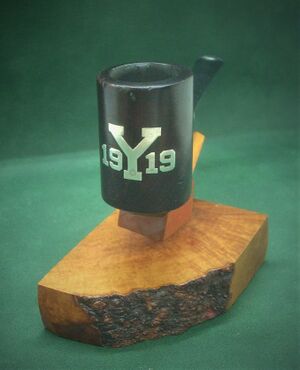
- Comoy's 1919 Yale University Class Pipe, with a silver band done by Comoy's to repair a small crack in the shank in 1938, as indicated by their hallmark. Courtesy Brian Robertson collection

- LHS-Sterncraft 1954 Yale University Class Pipe, courtesy Brian Robertson collection
- 1940 Brown University Kaywoodie Drinkless Class Pipe, courtesy Brian Robertson collection
- 1926 Cornell 'Percolator' Class Pipe, with a 1919 patent, courtesy Brian Robertson collection
Note: We have been unable to find any information about the Percolator pipe. It appears to have room in the shank and stem for a very large filter, or perhaps a sponge.
- 1949 Yale Class Pipe, an Owl Shop Jeffersonian, courtesy Brian Robertson collection
- Rare Carved Class Pipe, 1912 Dartmouth 'HUB' (possibly unofficial), courtesy Brian Robertson collection
Note: Carved Class Pipes were elected in the 1890's and seldom seen in the 1900's. Due to the inferior quality of the example above, it may be an unofficial one off.
- Circa 1950s Brown/Boston University Monogramed Class Pipe (possibly unofficial), courtesy Brian Robertson collection
- University of North Carolina Medico Alma Mater Class Pipe, courtesy Brian Roberston collection

- Syracuse University Comoy's Royal Falcon Class Pipe, courtesy Brian Roberston collection

- Circa 1950s Medico mail order class pipes (The P 59 was unofficially confirmed as Purdue), courtesy Brian Robertson collection
- 1946 Princeton Class Pipe, a Wally Frank 'The Bowler', courtesy Brian Robertson collection

- A 1911 BBB Glokar inlayed as a 1914 Cornell Class University Pipe. Apparently the student purchased the pipe during his freshman year. While freshmen could purchase class pipes, they could not smoke them until their sophomore year. Courtesy Brian Robertson collection
- 1923 University of Wisconsin Class Pipe, a BBB 'Own Make' Ultonia. Courtesy Brian Robertson collection
About this next example, Brian Robertson writes:
"Thanks to Hollywood I believed in the 1900's all early ivy league college students were children of wealth. I found an early Yale or Harvard student newspaper article asking what students would do during the summer. There were the "sailing evenings, off cape cod" and "golfing" . included however, were more than a few "farm labor on family farm". I wonder if this pipe was the evening product of just such a young man."
- 1906 Unofficial Harvard Missouri Meerschaum Class Pipe. Courtesy Brian Robertson collection
Brian reports having never see corn cob class pipe until getting the example above. Within 48 hours a neighbor stopped by and gave him this 38 Yale, having purchased it at a garage sale! The Missouri Meerschaum "Radio" model shown bellow in the 1938 Yale Class Pipe has at least two theories regarding the name. The hard stem mimics the Bakelite in early radios, and the brown button on the bottom of the pipe bowl resembles a radio knob. Also, read the description above of the 1906 Harvard corncob class pipe for more information about corn cob class pipes.
- Missouri Meerschaum 'Radio' Unofficial 1938 Yale Class Pipe. Courtesy Brian Robertson collection
- 1931 Unofficial Relief Carved 1931 Princeton Old Root Class Pipe. Courtesy Brian Robertson collection
Fraternity Pipes

- In addition to Class Pipes, there also came to be Fraternity pipes, as can be seen by this Alpha Tau Omega example, courtesy Brian Robertson collection
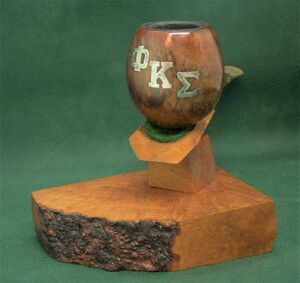
- Circa 1930s Kaufmann Bros. & Bondy, Kaywoodie Rocky Briar (model 1842) Phi Kappa Epsilon Fraternity Pipe, courtesy Brian Roberston Collection
- Phi Delta Theta Captain Black Fraternity Pipe, courtesy Brian Robertson Collection
- PSI Omega Dental Fraternity Pipe, a St. James by Comoy's, courtesy Brian Robertson Collection
- Alph Epsilon Lamda Amateur Carved Fraternity Pipe, a circa 1940s Kaufmann Bros. & Bondy Yello-Bole. Courtesy Brian Robertson Collection
Note: Introduced in the 1940's, the Stembiter model featured a beveled area in front of the stem button with a hole that went all the way through the twin bore stem. The feature was touted to end "stem chewing", and in their ads targeted smokers with "strong teeth"
A note of thanks
Acknowledgement and thank you to Steve Charbonneau/humblepipe. Many of the class pipes shown in the collection were in dire straits when obtained. Steve did amazing repairs and restoration to many of these pipes. He contributed his vast knowledge and talents to the ressurection of these pipes, purely, for the history and love of the hobby.












